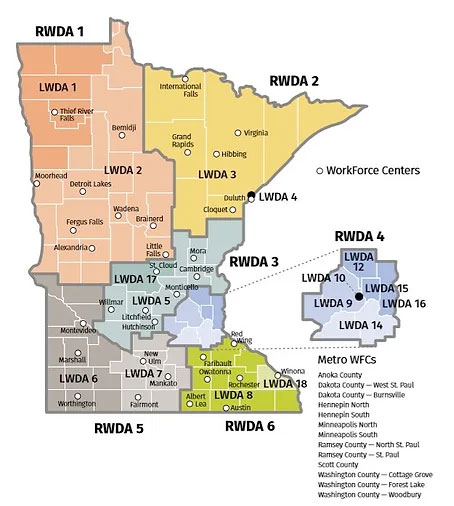Regional Designation and Planning Process

The Workforce Innovation and Opportunity Act (WIOA) was signed on July 22, 2014. It charged state and local elected officials and workforce boards with the responsibility to develop strategic local, regional and state plans. The US Department of Labor issued guidance that a Regional Plan must align with the State Plan and be developed collaboratively by two or more Local Workforce Development Boards and Chief Elected Officials. Regional boundaries are to be identified by the State in order to align workforce development activities and resources with larger economic development areas and available resources. Regional Plans are the big picture of a region’s economy and workforce environment. They outline a four-year approach to develop, align and integrate service delivery strategies and resources among multiple local workforce development areas.
MINNESOTA’S REGIONAL PLANNING PROCESS Minnesota’s approach to regional planning was based on WIOA requirements and our experience working in partnership with the Humphrey Institute of Public Policy and the Harvard School of Business in the mid 2000’s on regional economies. The State designated six workforce development planning regions. The process of identifying regions considered factors such as geographical size, population, migration patterns, and the workforce market. Minnesota’s six workforce regions align with its sixteen Local Workforce Areas and its federal Economic Development Areas. The regional plans contain two components – a narrative telling the story of the region; and a work plan outlining activities for the first two years of the regional plan.
MINNESOTA’S REGIONAL PLAN ELEMENTS Each Regional Plan showcases a distinctive regional economy and its respective strategies, actions and outcomes. The plans introduce and often enhance current initiatives that reflect each region and the spirit and intent of WIOA.
Across the state, there were six common Regional Plan accomplishments:
Regional leadership established - The purpose for establishing regional leadership is to ensure ownership and accountability for regional planning and oversight. This also allows local boards to establish different relationships and strategies than traditionally accomplished at the local level.
Regional service delivery identified - The purpose for regional service delivery is to identify new efficiencies and approaches that enhance customer outcomes and leveraging of resources across city and county boundaries.
Regional equity strategies defined - The purpose for equity strategies is to meet the Governor’s priorities in the State Combined Plan to address inequities in educational and employment outcomes for communities of color and individuals with disabilities.
Regional Industry partnerships determined - The purpose for industry partnerships is to meet the Governor’s priorities in the State Combined Plan to support Career Pathway development through industry led sector partnerships.
Regional stakeholder engagement summarized - The purpose for stakeholder engagement is to meet a State Combined Plan requirement for Career Pathway design. Bringing stakeholders together to understand the needs of business and identified equity populations is key to improving Career Pathway design.
Regional accountability framework - The purpose for an accountability framework is to provide a transparent measure of how progress is being made on the regional plans. This will be accomplished with individualized regional measures and a state-wide regional dashboard.
The information on this page is adapted from the GWDB's publication: Summary from Minnesota's WIOA Regional Plans
